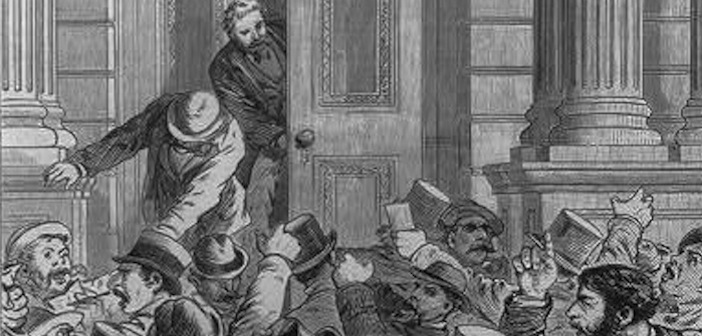Many Americans remember the Great Depression that left our country in financial ruin during the 1930’s.1 However, many of them are oblivious to the depression that was brought on by the Panic of 1873. Even fewer people are aware of the fact that the Panic of 1873 was dubbed the Great Depression until subsequent years when that title was won over by the decade encompassing the 1930’s.2 The 1930’s Great Depression, as we know it today, was brought on by a crash in the stock market (and various other factors, but mainly the events leading up to Black Tuesday, October 29, 1929).3 The Panic of 1873 had various causes that historians still debate for being the most responsible for the economic slump.

Unlike the Great Depression, the Panic of 1873 was brought on by high risk investments into the railroad building business. The demise of Jay Cooke & Company, the leading investor at the time, started a domino effect that was felt not only in the United States but also in Britain (triggering a severe two-decade long slump).4 The firm led financial efforts during the Civil War, and as a result of that, it became an agent for the federal government. Its promise was to build the second transcontinental railroad. By September 18, 1873, Cooke’s investment firm had declared bankruptcy.
The railroad building business was very risky; investors were essentially pouring their money into building industrial tracks leading to nowhere in hopes that the location would become prime locations for commerce. The leading firm, Jay Cooke & Company, decided to fold; a significant number of companies followed, approximately eighty-nine out of the existing three hundred sixty-four railroad companies.5 The majority of these companies declared bankruptcy within the first two years after Jay Cooke & Company declared bankruptcy, meaning that after having invested most of their monies into the railroad building business, most of those companies would rather take the loss than further invest any more money.6 This in turn caused more problems for the average citizen, because of the economic slump that would ensue.

Because industrialization was so vital for the early development of the United States, it is of no surprise that the railroad business was affected the most by that industrialization. The nation’s development was heavily rooted in the industrious railroad market of the time. Strikes, wage cuts, poor working conditions, less hours, and discrimination plagued the few in the working force. Panic had set in. Men were no longer able to provide for their families as they once did because of the decrease in pay and hours.7 This set up a perfect recipe for employers to take advantage; now they could demand more work for less pay because the unemployment rate was so high (peaking at 14%), so anybody looking for a job would have to take what they could.8 This employment competition led to poorer working conditions and even more discrimination, because any working class citizen would do whatever it took to survive during this time period.

The Panic of 1873 had some disastrous consequences. Aside from the corrupt politics of the time (for example, the Grant Administration Scandals), and the economic tatters the country was left in, the country’s values began to disintegrate as well. One of the most commonly known events, the Haymarket Affair, left seven people dead by a dynamite bomb during a labor demonstration, and many others were severely wounded.9 It seemed like the country would never recover; troops were deployed to various demonstrations as “peace keepers,” but only more violence would ensue. In order for change to occur, new methods would have to be implemented.
The Panic of 1873 never really ended; various factors ultimately led to an upward trend in the economy, and in turn, the growth of the nation again. Investors began to be more cautious with their monies, the government took responsibility for the corruption, and ultimately the country’s morale began to boost. This upward trend led the nation out of its first great depression.
- Alison Cook-Sather and John E Moser, Global Great Depression and the Coming of World War II, U.S. History in International Perspective (Boulder: Routledge, 2015), 8-9. ↵
- Francois Furstenberg, “What history teaches us about the welfare state,” The Washington Post, July 1, 2011. ↵
- Cook-Sather and Moser, Global Great Depression, 51. ↵
- Alan Brinkley, American History, 15th ed., vol. 2: from 1865 (2 Penn Plaza, New York, NY 10121: McGraw Hill Education, 2015), 413. ↵
- Francois Furstenberg, “What history teaches us about the welfare state,” The Washington Post, July 1, 2011. ↵
- John M. Lubetkin, Jay Cooke’s Gamble: The Northern Pacific Railroad, the Sioux, and the Panic of 1873 (Norman:University of Oklahoma Press, 2014), 5, 15. ↵
- Hans Rosenberg, “Political And Social Consequences Of The Great Depression Of 1873‐1896 in Central Europe,” The Economic History Review 13, no. 1‐2 (1943): 69. ↵
- Rosenberg, “Political and Social Consequences of the Great Depression,” 60. ↵
- “Ulysses S. Grant – Part One: Warrior,” American Experience, directed by Adriana Bosch (Arlington, Virginia: WGBH, 2005), DVD. ↵



37 comments
Oscar Ortega
This article does a great job of explaining The Panic of 1873. As the article suggests, it is rather obscure to most, and I did not know it existed, let alone any specifics regarding the cause or its effects, but this article explains all of them very clearly without bogging itself down. The story itself is rather familiar, certain economic risks didn’t pay off, but enough had taken said risk to cause an imbalance that was difficult to recover from and left the American economy and society in ruin. However, the fact that the Panic is not nearly as well-known as the Great Depression of the 1930s is a shame, as it is equally important, and this article explains why.
Christopher Hohman
Nice article. The Great Depression of 1873 was an event that shocked the nation. In the end though it did not compare to the Great Depression of the 1930s. The unemployment rate during the 1930s peaked about 25 percent which is insanely high. Still though, 14 percent is also a really high rate of unemployment. It is interesting that the economy struggled along for almost twenty years after.
Eric Ortega Rodriguez
I have never heard of The Panic Of 1873 before reading this article. I wish I would have known about this event sooner, I also believe that this is something that is often not talked about. What I found fascinating was that as I was reading the article, I noticed how interconnected the economy is. That when one section of the economy falls, others fall as a response to it. Overall, this was a very fascinating article and I believe that we can learn from events such as this one to prevent any more damages in the economy and on people.
Valeria Perez
I did not know there was a Great Depression before the Great Depression of the 1930’s! Being a country just coming out of the Civil War and trying to build itself up only to fall into this economic state must have seem helpless for the people. Though it is sad, seeing this issue from the future it seemed inevitable for this economic crash to happen. How do you start building railroad tracks, which are not cheap, randomly and hope one of them turns into an economic center?
Honoka Sasahara
I can imagine that it’s so hard to live right in the middle of a recession. In a hopeless situation or panic like this case, people must not be able to feel safe from the bottom of their hearts. In a few years I will graduate a school and have to work, so I thought after reading this article that I should think more seriously about economic situation in my country.
Noah Bolhuis
I hadn’t ever been taught about this economic crash, so it was interesting to read. This is another example of how monopolies, or near monopolies, are extremely dangerous and can crash any economy. The industrial industry, especially the railroads, were a rising investment for nearly every investor. With trains and railroads popping up all over the country and taking people to new places and having major cities come up around them, it is no wonder people had most of their money in this. So it makes sense that one leading company in a leading industry could ruin the economy.
Eric Ortega Rodriguez
This is the first time I hear about The Panic Of 1873 and I can honestly say I am disappointed I never learned about this before. I also find it incredibly courageous for the investors of railroad companies to invest in a business that might or might not succeed. It is fascinating to see how interconnected the economy is. When the railroad business failed it led to lower wages the domino effect. I believe events such as this one along with The Great Depression in 1929 should be used as a learning experience, ensuring our economy, and our people, are safe.
Robert Rodriguez
I found it crazy how one industry caused such a catastrophe to the economy to happen, I Never realized that there were that many failed railroad companies during that time and it surprised me more that these companies closed after an average of 2 years. I was also not aware of the events of the Haymarket Affair, that unbelievable that the U.S was in a literal panic. this was so informative, such a great article! good job!
Kailan Pena
I find it so interesting that so many people decided to risk putting most to all of their money into one investment. It seems like the idea of it was just too risky for me to do, but it’s sad that so many people did so and lost so much. The financial welfare of most citizens of the time was dependent on the financial welfare of a single company and when it drowned, so did all the investors and that’s tragic. But on a lighter note, this was a great article and I can say I learned a lot from this, I had no idea this “Panic” ever existed before reading this honestly.
Saira Castellanos
No surprise that the railroad companies had to with the panic. They were a huge monopoly which ultimately affected the economy. I did not know that these panics were a thing though. I thought it was just the stock crashing in the Great Depression. No one really talks about any panics before the Great Depression as far as i know. Its kind of weird to me now knowing that the Great Depression was not the first, but no one talks about this so how is anyone suppose to know. What also surprised me was all the choas that this panic caused and all the violence. Great article.